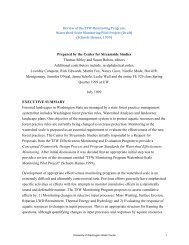Copyright 2012 Aileen M. Echiverri-Cohen - University of Washington
Copyright 2012 Aileen M. Echiverri-Cohen - University of Washington
Copyright 2012 Aileen M. Echiverri-Cohen - University of Washington
Create successful ePaper yourself
Turn your PDF publications into a flip-book with our unique Google optimized e-Paper software.
using neutral stimuli, were associated with re-experiencing symptoms (Vasterling, 2000),<br />
suggesting that failure to inhibit intrusions <strong>of</strong> irrelevant information may not be restricted to<br />
emotionally threatening content. Similarly, hypervigilance symptoms may be associated with<br />
difficulties in differentiating relevant from irrelevant information by utilizing cognitive<br />
processing resources that prohibit one’s ability to rule out maladaptive behaviors (Lee, Vaughn,<br />
& Armstrong, 1999). Taken together, deficient temporal attention may be particularly relevant in<br />
the reexperiencing and hyperarousal symptoms <strong>of</strong> PTSD because <strong>of</strong> their role in increasing<br />
demands on attentional allocation (Keller, Hicks, & Miller, 2000) and subsequently may be more<br />
responsive to treatments that directly target deficits in temporal attention. Indeed, PE is thought<br />
to utilize extinction to dampen chronic fear responses by strengthening prefrontal functioning<br />
(Felmingham et al., 2007; Porto, Oliveira, Mari, Volchan, Figueira, & Ventura, 2009),<br />
presumably through correcting pathological elements <strong>of</strong> fear structures and changing<br />
pathological beliefs (Jaycox, Foa & Morral, 1998). As a consequence, PE may directly target<br />
reexperiencing and hyperarousal symptoms related to increased distractibility, poor memory, and<br />
concentration problems associated with the disorder (Uddo et al., 1993; Wolfe & Charney,<br />
1991), in addition to “freeing” up attentional resources to differentiate between maladaptive and<br />
adaptive behaviors (Lee et al., 1999) and to differentiate between remembering and<br />
reexperiencing <strong>of</strong> the trauma (Jaycox et al., 1998). Thus, PE may act in improving functioning <strong>of</strong><br />
the prefrontal-amygdala circuit and subsequently regulating rexperiencing and hyperarousal<br />
symptoms in PTSD.<br />
Consistent with this, differential modulation <strong>of</strong> inhibition across treatments in responders<br />
points to potentially different mechanisms <strong>of</strong> treatment response in PE and SER. As discussed<br />
before, PE is thought to act on the mPFC, anterior cingulate and other cortical areas that have<br />
42
















